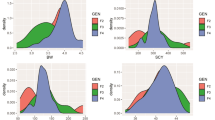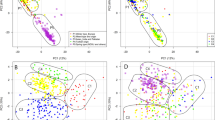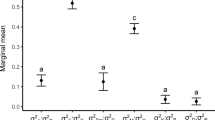Abstract
The additive genotypic variance, D, estimated with the F3 of autogamous crops can be taken as an estimate of genotypic variance of its F∞-progeny. Two possible ways of estimating D are compared on the basis of their mean square error. For each of the two estimators the F3-population design, i.e., the number of lines, the number of plants per line and the number of parent plants, is chosen such that for a given experimental capacity its mean square error is minimal. Subsequently the two estimators are compared for various combinations of F∞-heritability, dominance level and experimental size. In by far the most cases the second estimator, D2, which takes twice the between F3-line genotypic variance as its estimate, outperforms the first estimator, D1, which uses both the between and the within F3-line genotypic variance. Further it is shown that, when it is necessary to work with plot totals because of low F∞-heritability, the performance of D1 becomes very poor. With respect to the estimator of the dominance component of genotypic variance, H, its very large mean square error and its highly negative correlation with D1 are demonstrated.
Similar content being viewed by others
Article PDF
References
Jinks, J L, and Pooni, H S. 1976. Predicting the properties of recombinant inbred lines derived by single seed descent. Heredity, 36, 253–266.
Jinks, J L, and Pooni, H S. 1980. Comparing predictions of mean performance and environmental sensitivity of recombinant inbred lines based upon F3 and triple test cross families. Heredity, 45, 305–312.
Jinks, J L, and Pooni, H S. 1982. Predicting the properties of pure breeding lines extractable from a cross in the presence of linkage. Heredity, 49, 265–270.
Kearsey, M J. 1985. The effect of linkage on additive genetic variance with inbreeding an F2. Heredity, 55, 139–143.
Mather, K, and Jinks, J L. 1971. Biometrical Genetics, 2nd edn. Chapman and Hall, London, 382pp.
Ooijen, JW van. 1986. Distribution of estimates of genetic variance components in self fertilising crops. In Biometrics in Plant Breeding, Proceedings of the 6th Meeting of the Eucarpia Section Biometrics in Plant Breeding, University of Birmingham, U.K., pp. 59–69.
Pooni, H S, and Jinks, J L. 1979. Sources and biases of the predictors of the properties of recombinant inbreds produced by single seed descent. Heredity, 42, 41–48.
Pooni, H S, and Jinks, J L. 1986. Estimation of the true additive genetic variance in the presence of linkage disequilibrium. Heredity, 57, 341–344.
Shaw, R G. 1987. Maximum-likelihood approaches applied to quantitative genetics of natural populations. Evolution, 41, 812–826.
Smith, H F. 1938. An empirical law describing heterogeneity in the yields of agricultural crops. Journal of Agricultural Science, 28, 1–23.
van der Veen, J H, . 1959. Tests of non-allelic interaction and linkage for quantitative characters in generations derived from two diploid pure lines. Genetica, 30, 201–232.
Weber, W E. 1982. Estimation of genetic variance components under linkage and sampling errors in self fertilizing crops. Agronomie, 2, 201–212.
Author information
Authors and Affiliations
Rights and permissions
About this article
Cite this article
van Ooijen, J. Estimation of additive genotypic variance with the F3 of autogamous crops. Heredity 63, 73–81 (1989). https://doi.org/10.1038/hdy.1989.77
Received:
Issue date:
DOI: https://doi.org/10.1038/hdy.1989.77
This article is cited by
-
Genetics of nitrate content in lettuce
Euphytica (1992)
-
A comparison between single seed descent and early cross selection in wheat breeding
Euphytica (1991)



